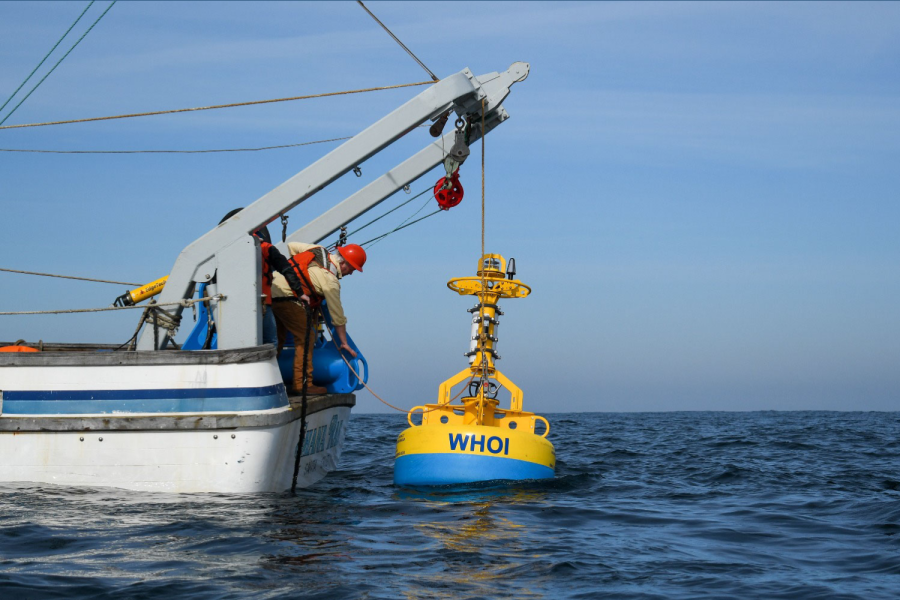A beloved San Francisco Bay whale washed ashore dead last August. That whale was Fran, the most popular and photographed humpback in the San Francisco Bay, with 277 recorded sightings since 2005.
Fran was the fifth whale confirmed to be killed by a ship strike in the area that year, according to The Marine Mammal Center.
Ships, especially massive container vessels, are some of the leading killers of whales. Scientists estimate that over 80 endangered whales are killed annually by ship strikes off the West Coast.
To combat this issue, a high-tech initiative called Whale Safe has designed a solution powered by artificial intelligence (AI).
The Whale Safe project is a whale detection system that displays near real-time whale and ship data, with the goal of preventing fatal ship collisions with whales. It incorporates acoustic and visual whale detections with model predictions to provide mariners with updated information on whale presence in busy shipping areas. This is possible with the help of buoys that carry onboard computers and record whale sounds using underwater microphones.
According to Rachel Rhodes, a project scientist working on Whale Safe at the Benioff Ocean Science Laboratory, many whale populations have been on the brink of extinction over the past few hundred years, and today numerous species remain threatened.
“As global maritime traffic continues to increase, it is critical that we implement solutions now to protect endangered whales. Encouraging ships to slow down to reduce the risk of whale-ship collisions is a triple win. It saves whales, helps fight climate change through carbon sequestration, and improves air quality,” Rhodes said. “When ships slow down, they emit fewer greenhouse gas emissions, nitrogen oxides, and other harmful air pollutants that exacerbate diseases like asthma for vulnerable populations like kids and the elderly.”
Whale Safe also provides vessel speed analytics on its website. Using Automated Identification System (AIS) data to monitor large ship speeds, operators are given a report card with an overall grade based on how often their fleet follows recommendations to slow down.
The overall cooperation rate of vessels slowing down to 10 knots or less in the Santa Barbara Channel in 2020 was about 54%, and now it is almost 62%, according to Callie Leiphardt, another Whale Safe project scientist at the Benioff Ocean Science Laboratory.
“This cooperation rate is trending in the right direction, but we would like to see it closer to 100%, which means we still have more work to do,” Leiphardt said.
Unfortunately, 2018, 2019, and 2021 were some of the worst years on record for ship strikes off the coast of California, with 10 confirmed deaths in 2018, 11 deaths in 2019, and eight deaths in 2021.
These reported deaths most likely represent only 5% to 17% of ship strike mortalities because struck whales tend to sink to the ocean floor upon death, so the actual toll could be closer to 100 whales, according to Leiphardt.
Whale deaths also can significantly impact major factors such as ocean health and climate change.
“Whales are among the largest creatures on Earth and play vital roles in maintaining a healthy ocean and climate, stabilizing the marine food web, and strengthening our economy – whale watching brings in billions of dollars helping stimulate coastal economies worldwide,” Leiphardt said.
Researchers have discovered that whales sequester large volumes of carbon dioxide in their bodies, while their excrement leads to the growth of phytoplankton, which locks in a massive amount of carbon from the atmosphere. A recent study by the International Monetary Fund suggested that protecting whales could be one of the most efficient ways of mediating climate change.
Many marine life and whale conservation organizations and projects, such as Whale Safe, continue working on learning more about whales and ways to mitigate the number of deaths to help preserve both the atmosphere and aquatic conditions.
“Whales, like so many other animals, face an uncertain future. We need to do whatever we can to protect them. Some issues, such as climate change and chemical pollution, are extremely difficult to stop. But for other issues, there are viable solutions. This includes ship strikes,” said Andy Rogan, the science manager at Ocean Alliance and a marine mammal biologist.
A 2021 study published in the journal Frontiers in Marine Science estimated that whale deaths in the Santa Barbara Channel could drop by a third if 95% of ships abided by the speed limits.
“We continue to do outreach with shipping companies, navigation software companies, and other major players in this space to try to make our Whale Safe data as accessible and easy to use as possible and to encourage more vessels to slow down,” Rhodes said.
Even the Antarctic blue whale, the biggest animal on the planet, weighing up to 200 tons, is no match for these huge vessels. Large cargo ships, often carrying tens of thousands of containers, can weigh over 200,000 tons.
“As consumers, it’s an issue we are all connected to since so many of our purchased and used goods are shipped, but it’s unfortunately not an issue that many of us attribute as a big threat to whales,” Leiphardt said.
Still, activities such as whale watching and the overall wonder that whales bring to the oceans have created a great amount of awareness of the harm to the oceans currently being caused by various factors.
“As beautiful, dynamic, and charismatic animals with well-documented intelligence, they have an extraordinary ability to inspire and stimulate the connections between the ocean and the public that are at present so desperately needed,” Rogan said.























